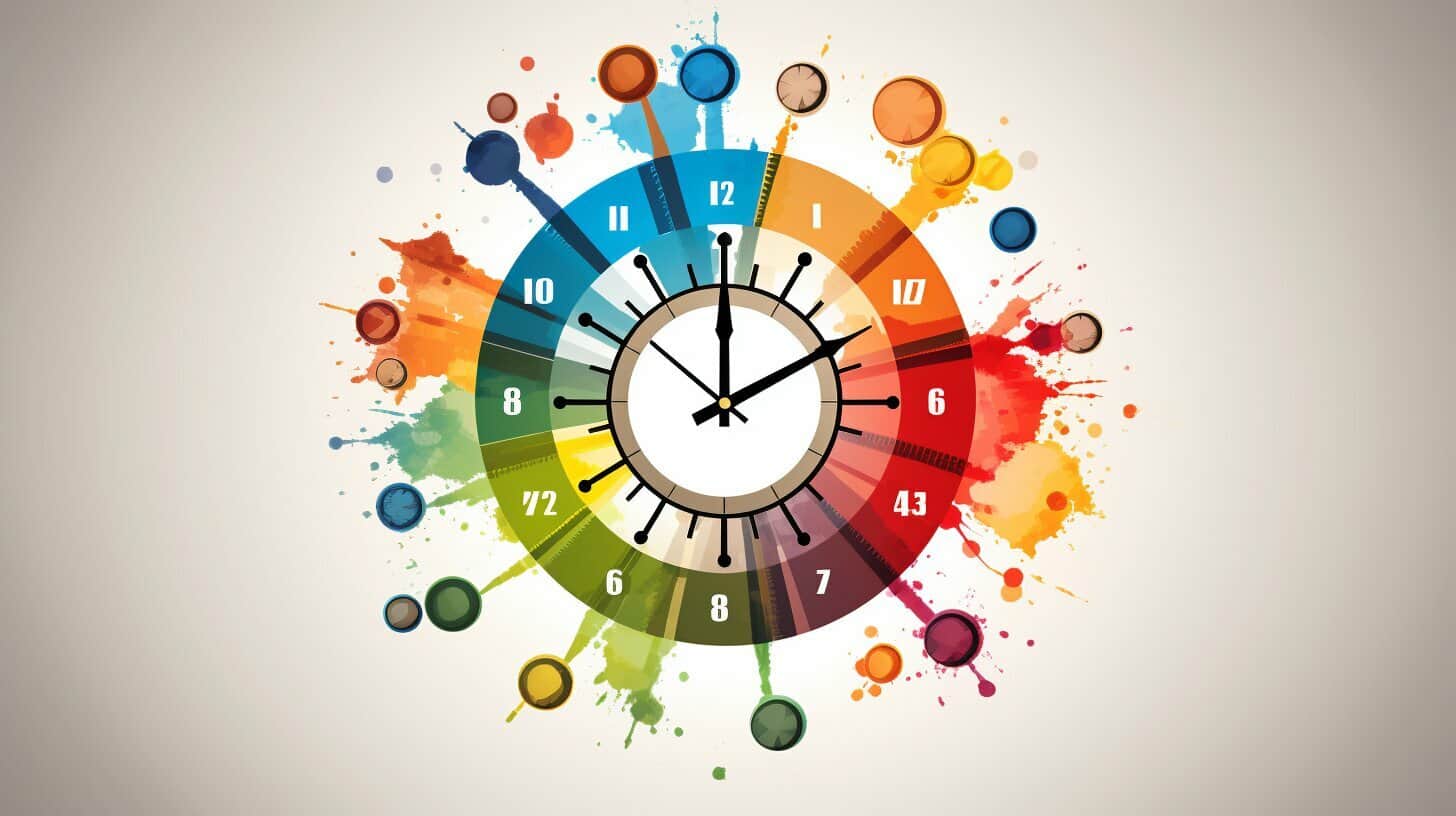As a professional constantly on the go, I understand the importance of making the most of every moment. With endless tasks and responsibilities, it can be difficult to prioritize and be as productive as possible on a daily basis. But fear not, I’ve gathered some top tips and strategies guaranteed to help you get more out of your day and maximize your productivity.
Key Takeaways:
- Learn how to prioritize tasks for maximum efficiency
- Create an effective daily routine to maximize productivity
- Set realistic goals and use time management techniques to improve daily productivity
- Eliminate time-wasting activities with effective time-saving strategies
- Delegate and outsource tasks to increase efficiency with time management hacks
- Use technology to your advantage for time-saving strategies to maximize productivity
- Take regular breaks to recharge and enhance productivity
- Practice mindfulness and focus for productivity tips and time management techniques
- Optimize your workspace to increase efficiency with time management hacks
- Maintain a healthy work-life balance for long-term productivity
Prioritize Tasks for Maximum Efficiency
When it comes to productivity, prioritizing tasks is key. By focusing on the most important tasks first, we can increase efficiency and accomplish more in less time. Here are some tips for prioritizing tasks:
1. Make a to-do list
Start each day by making a list of tasks that need to be completed. This will help you stay organized and focused on what needs to be done.
2. Assign priorities
Assign priorities to each task. Use labels like “high priority,” “medium priority,” and “low priority” to determine which tasks require the most attention.
| Priority | Task Examples |
|---|---|
| High Priority | Deadline-driven projects, urgent emails, meetings |
| Medium Priority | Follow-ups, non-urgent emails, routine tasks |
| Low Priority | Long-term projects, personal tasks, low-value activities |
3. Consider deadlines
Take into account any deadlines associated with the tasks. Prioritize tasks with impending due dates to ensure they are completed on time.
4. Be flexible
Be flexible and adjust priorities as needed. Unexpected tasks or emergencies may arise, requiring you to shift your focus.
By prioritizing tasks, we can increase efficiency and accomplish more in less time. Start by making a to-do list, assigning priorities, considering deadlines, and remaining flexible. With practice, you’ll be able to prioritize effectively and achieve your goals with ease.
Create an Effective Daily Routine
One of the most effective ways to maximize productivity and get more out of your day is to establish an effective daily routine. Having a routine helps to create structure and order in your day, reducing stress and increasing productivity. Here are some strategies for creating an effective daily routine:
- Identify your top priorities: Start by identifying the tasks that are most important for the day. This will help you to focus on what really matters and avoid getting distracted by less important tasks.
- Establish a consistent wake-up time: Waking up at the same time every day helps to regulate your body clock and improve sleep quality. Set an alarm for the same time each morning and try to stick to it, even on weekends.
- Plan out your day: Use a planner or a to-do list to map out your day. This will help you to stay organized and ensure that you don’t forget any important tasks.
- Break your day into blocks: Divide your day into specific blocks of time for each task. This helps to create a sense of urgency and helps to prevent procrastination.
- Schedule regular breaks: Taking short breaks throughout the day helps to recharge your energy levels and improve overall productivity. Schedule short breaks into your routine, such as a 10-minute break every hour or a longer break mid-morning and mid-afternoon.
Creating an effective daily routine takes time and practice to perfect, but the benefits are enormous. By implementing these strategies, I have found that I am more productive, less stressed, and have more time to pursue my hobbies and interests outside of work. Give it a try and see how it can improve your daily productivity!
Set Realistic Goals
When it comes to managing time and improving daily productivity, one of the most important things to do is to set realistic goals. This not only helps to keep you focused and motivated, but it also allows for better time management and helps you to avoid feeling overwhelmed.
One of the best time management techniques for setting realistic goals is to break them down into smaller, more achievable tasks. This makes it easier to prioritize and manage your time effectively, as you can focus on completing one task at a time, rather than trying to do everything at once.
Time Management Techniques for Setting Realistic Goals
Here are some time management techniques that can help you set and achieve realistic goals:
- Be specific: When setting your goals, be as specific as possible. This will help you to focus on the task at hand and avoid getting sidetracked.
- Set deadlines: Setting deadlines for each task can help you to stay on track and ensure that you complete everything on time.
- Prioritize: Prioritizing your goals can help you to focus on the most important tasks first, ensuring that you make the most of your time.
- Break it down: Breaking your goals down into smaller, more achievable tasks can make them easier to manage and increase the likelihood of success.
- Track your progress: Keeping track of your progress can help you to stay motivated and make adjustments as needed.
By implementing these time management techniques, you can set realistic goals and improve your daily productivity to achieve your desired outcomes.
Eliminate Time-Wasting Activities
One of the biggest obstacles to productivity is indulging in time-wasting activities. These distractions can quickly drain your energy and take away precious hours from your workday.
To combat these time-wasters, start by identifying them. Do you spend too much time scrolling through social media? Or find yourself getting sidetracked by non-urgent emails? Once you know what’s distracting you, take steps to eliminate or minimize your exposure to them.
Here are some time-saving strategies to consider:
| Strategy | Description |
|---|---|
| Time-blocking | Schedule your day in advance and block out specific times for tasks. This helps you stay focused and avoid getting pulled away by other projects. |
| Set boundaries | If you work from home or have coworkers who frequently interrupt you, set clear boundaries. Make it known when you’re unavailable or use tools like noise-cancelling headphones to signal when you need to focus. |
| Use productivity apps | There are plenty of apps out there designed to help you stay focused and avoid distractions. Examples include Forest, Freedom, and RescueTime. |
By taking steps to eliminate time-wasting activities, you’ll be able to free up more of your day for the tasks that truly matter.
Delegate and Outsource Tasks
One of the most effective time management hacks I’ve learned is to delegate tasks that can be handled by others. As much as we want to do everything ourselves, it’s not always feasible or efficient. Delegating tasks to others allows us to focus on more important tasks that require our expertise, and increases overall productivity.
When deciding which tasks to delegate, consider the following:
- Tasks that are repetitive or time-consuming
- Tasks that are not within your area of expertise
- Tasks that can be done by someone else more efficiently
Outsourcing is also a great option, especially for tasks that require specialized skills. Freelance websites such as Upwork and Fiverr offer a variety of services at a reasonable cost. This allows you to focus on tasks that require your attention, while leaving specialized work to the experts.
When delegating or outsourcing tasks, it’s important to clearly communicate your expectations and deadlines. Provide clear instructions and feedback to ensure that the work is done to your satisfaction. By delegating and outsourcing tasks, you can increase efficiency and focus on what truly matters.
Use Technology to Your Advantage
Technology can be a powerful tool for maximizing productivity and saving time. Here are some ways to use technology to your advantage:
- Use apps for task management: There are numerous apps available that can help you organize your to-do list, set reminders, and prioritize tasks. My personal favorites are Todoist and Trello.
- Automate repetitive tasks: If you find yourself doing the same task over and over again, consider automating it. For example, you can use tools like IFTTT or Zapier to automate tasks between different apps.
- Take advantage of keyboard shortcuts: Keyboard shortcuts can save you a lot of time and make your work more efficient. Take some time to learn the shortcuts for the programs you use most often.
- Use online collaboration tools: Online collaboration tools like Google Docs and Slack can make it easier to work with colleagues and streamline communication.
- Utilize time-tracking software: If you’re having trouble staying focused, try using time-tracking software like Toggl. It can help you identify which tasks are taking up too much time and where you can make adjustments.
By incorporating these technology hacks into your daily routine, you can save time, increase efficiency, and ultimately get more out of your day.
Take Regular Breaks
One of the most counterintuitive yet effective productivity tips is to take regular breaks throughout the day. As much as we may think that working non-stop is the key to getting more done, studies have shown that taking breaks can actually help improve focus and productivity.
When I feel myself getting mentally exhausted or overwhelmed, I make sure to take a 5-10 minute break to step away from my work and clear my mind. During this time, I might go for a quick walk outside, listen to my favorite song, or simply close my eyes and take deep breaths.
It’s important to note that breaks should be intentional and not just mindlessly scrolling through social media. One technique I’ve found helpful is the Pomodoro Technique, which involves working for 25 minutes straight followed by a 5-minute break. After four “pomodoros,” take a longer break of around 20-30 minutes.
By taking regular breaks, you’ll find that you’re able to maintain your focus and energy throughout the day, ultimately leading to increased productivity.
Practice Mindfulness and Focus
Another important aspect of maximizing productivity is practicing mindfulness and focus. It’s easy to get swept up in the chaos of daily tasks and lose sight of what’s truly important, but taking the time to stay present and focused can help you stay on track and get more done.
Techniques for Mindfulness and Focus
One technique that works well for me is the Pomodoro technique. This involves working for 25 minutes and then taking a 5-minute break, repeating the process several times throughout the day. This helps me stay focused during my work sessions and allows me to take short breaks to recharge.
Another technique is to practice meditation or breathing exercises. Taking a few minutes each day to clear your mind and focus on your breath can help you stay calm and centered throughout the day.
Reducing Distractions
In addition to practicing mindfulness and focus, it’s important to reduce distractions as much as possible. This may involve turning off your phone notifications, closing unnecessary tabs on your computer, or finding a quiet space to work.
It can also be helpful to set boundaries with your colleagues or family members to ensure you have uninterrupted work time when you need it. Communicating your needs clearly and respectfully can go a long way in minimizing distractions and maximizing your productivity.
Optimize Your Workspace
Having an optimized workspace can greatly enhance your productivity. Here are some tips on how to organize and declutter your workspace:
| Tip | Description |
|---|---|
| Clear the Clutter | Remove any unnecessary items from your workspace to avoid distractions and create a cleaner environment. |
| Keep it Organized | Have a designated place for everything on your desk to avoid misplacing important documents or items. |
| Maximize Natural Light | Position your desk to maximize natural light exposure, as it can improve mood and energy levels. |
| Add Personal Touches | Whether it’s a family photo or a favorite plant, adding personal touches to your workspace can make it more comfortable and inviting. |
Remember, an optimized workspace is essential for maximum productivity. Take some time to declutter and organize your workspace today!
Maintain a Healthy Work-Life Balance
As someone who values productivity and getting more done in a day, it can be tempting to let work consume my life. However, I’ve learned that maintaining a healthy work-life balance is essential for long-term productivity and overall well-being. Here are some strategies I use to ensure I’m not sacrificing my personal life for work:
- Set boundaries: It’s important to establish clear boundaries between work and personal time. This could mean turning off work notifications during off-hours, not checking email after a certain time of day, or setting specific work hours and sticking to them.
- Make time for hobbies and self-care: Taking time for hobbies or activities that bring you joy can help you recharge and come back to work feeling refreshed. Additionally, making time for self-care activities, such as exercise or meditation, can improve your mood and reduce stress.
- Take vacations: Taking time off work, whether it’s a weekend getaway or a longer vacation, can help you disconnect from work and come back with a fresh perspective. It’s important to use vacation time to truly relax and recharge, rather than trying to catch up on work.
- Stay organized: Being organized and efficient with your time can help you get work done more quickly, leaving more time for personal activities. Additionally, keeping a calendar or to-do list can help you prioritize and manage your time effectively.
Remember, your personal life is just as important as your work life. By maintaining a healthy work-life balance, you’ll be able to achieve long-term productivity and overall happiness.
Conclusion
As someone who has struggled with productivity in the past, I know firsthand how challenging it can be to get more out of your day. However, by implementing the tips and strategies discussed throughout this article, I have been able to significantly increase my productivity and achieve more in less time.
Remember, the key to success is not about working harder, but working smarter. By prioritizing tasks, creating an effective daily routine, setting realistic goals, and eliminating time-wasting activities, you can make the most of your time and achieve your goals faster than you ever thought possible.
Delegating and outsourcing tasks, using technology to your advantage, taking regular breaks, practicing mindfulness and focus, optimizing your workspace, and maintaining a healthy work-life balance are all additional strategies that can take your productivity to the next level.
So what are you waiting for? Start implementing these tips and strategies today and get more out of your day!
FAQ
Q: How can I prioritize tasks for maximum efficiency?
A: Prioritizing tasks is essential for increasing efficiency. Start by identifying the most important tasks and tackle them first. Break larger tasks into smaller, manageable steps, and set realistic deadlines. Utilize to-do lists or task management tools to keep track of your priorities.
Q: How can I create an effective daily routine?
A: Creating an effective daily routine can maximize productivity. Start by identifying your peak energy times and allocate them for your most important tasks. Create a schedule that includes dedicated time for important activities like exercise and self-care. Be consistent and flexible, adjusting your routine as needed.
Q: Why is setting realistic goals important for daily productivity?
A: Setting realistic goals helps to manage your time effectively. Break down larger goals into smaller, achievable tasks. Prioritize your goals based on their importance and allocate dedicated time to work on them. Regularly review and adjust your goals as needed to stay on track.
Q: How can I eliminate time-wasting activities?
A: Identifying and eliminating time-wasting activities is crucial for productivity. Start by identifying activities that don’t contribute to your goals or values. Set boundaries and learn to say no to tasks that can be delegated or aren’t a priority. Utilize productivity techniques, such as time blocking, to stay focused and avoid distractions.
Q: How can I delegate and outsource tasks effectively?
A: Delegating and outsourcing tasks can increase efficiency. Identify tasks that can be handled by others and delegate them to the appropriate individuals. Clearly communicate your expectations and provide necessary resources. Consider outsourcing tasks to professionals or utilizing freelancers for specialized tasks.
Q: How can I use technology to my advantage for productivity?
A: Technology offers numerous time-saving strategies. Utilize productivity apps and tools to streamline tasks and stay organized. Set up automated reminders and notifications for important deadlines. Use project management software to collaborate effectively with teams. Remember to balance technology use with mindful, focused work.
Q: Why are regular breaks important for productivity?
A: Taking regular breaks is essential for maintaining productivity. Breaks help to recharge your brain and prevent burnout. Incorporate short breaks throughout your workday, such as taking a walk or doing a quick stretch. Use techniques like the Pomodoro Technique, where you work for a set amount of time and then take a short break.
Q: How can I practice mindfulness and focus for increased productivity?
A: Practicing mindfulness and focus can enhance productivity. Minimize distractions by creating a designated work area and turning off notifications. Practice techniques like deep breathing or meditation to calm your mind and stay present. Use time management techniques like the “80/20 rule” to prioritize tasks and eliminate non-essential activities.
Q: How can I optimize my workspace for increased efficiency?
A: An optimized workspace can boost efficiency. Declutter your workspace and organize it in a way that promotes productivity. Ensure you have proper lighting and ergonomic furniture. Minimize distractions and personalize your space with items that inspire and motivate you.
Q: How can I maintain a healthy work-life balance?
A: Maintaining a healthy work-life balance is crucial for long-term productivity. Set boundaries between work and personal life, and establish dedicated time for relaxation and hobbies. Prioritize self-care and make time for activities that recharge you. Learn to disconnect from work during non-working hours to maintain a healthy balance.





Leave a Reply